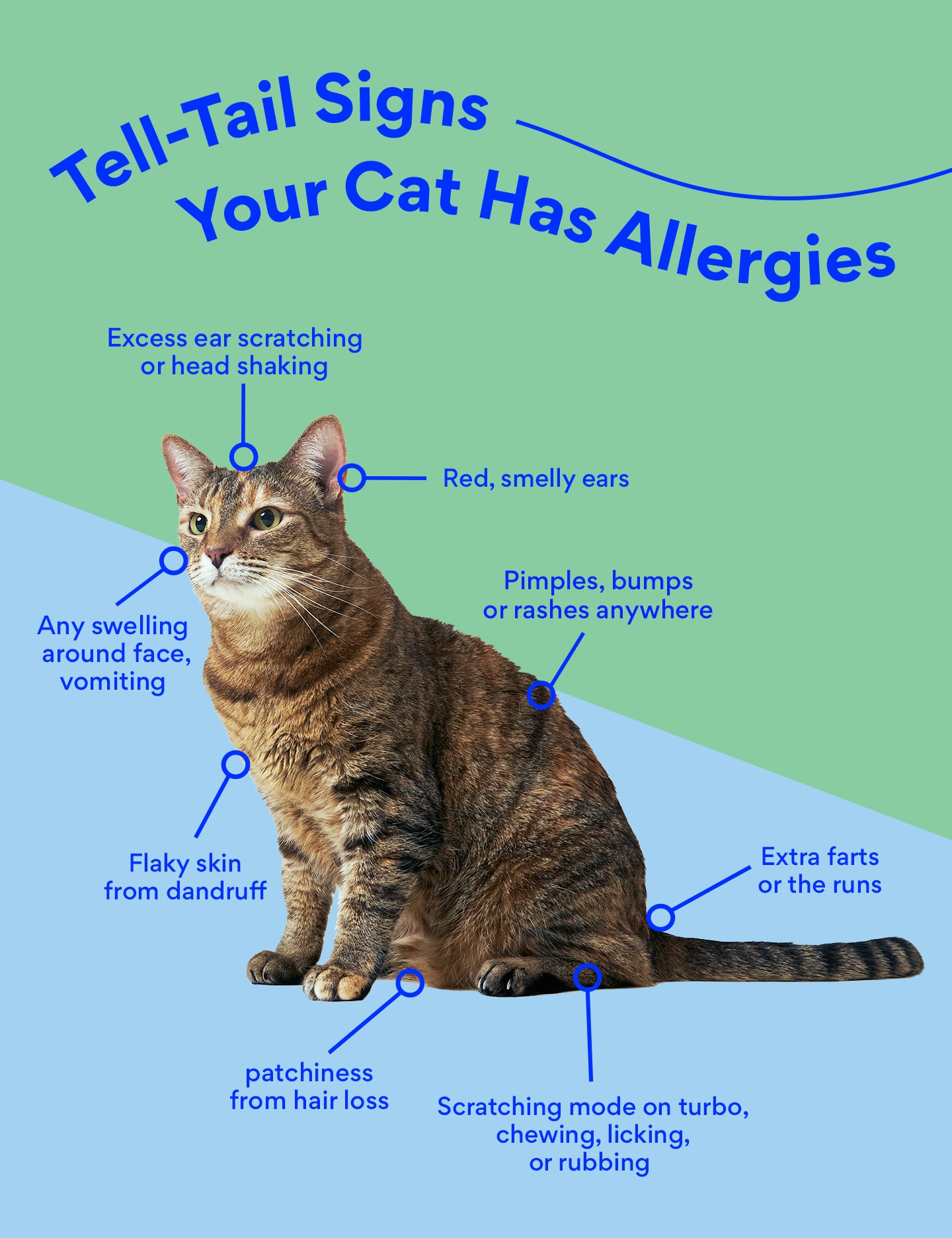Itchy skin, hair loss, skin and ear infections: Allergies in cats can manifest in many ways—none of which are particularly comfortable for your furry friend. Luckily, though, there are several options for allergy relief in cats, including treatments from your veterinarian, easy home remedies for cat allergies, and over-the-counter options that only require a visit to your local drug store.
It is always advised to talk to your veterinarian and get a diagnosis of allergies before treating an allergic cat. This is because many other skin conditions such as bacterial skin infections or mites have similar signs to skin allergies but require different treatments. Always work with your veterinarian if you have a cat with allergy symptoms to get to the bottom of the problem and solve it, if possible.
All About Cat Allergies:

Diagnosing Cat Allergies
While the true prevalence of allergies in cats is unknown, it’s believed to affect anywhere from 10 to 15 percent of cats. And one of the most common cat allergies? Flea allergy dermatitis, which is among one of three main skin allergies in cats:
1 Flea Allergy Dermatitis
Flea allergy dermatitis (FAD) is caused by an allergic reaction to flea saliva.
The classic signs of FAD in cats include:
- Itching
- scratching around the head and neck
- miliary dermatitis along the back
- hair loss
- scabs around the base of the tail or around the head and neck
You may or may not see fleas.
FAD can be so intense that it takes just the bite of one passing flea to make a cat miserable and pull their hair out!
2 Environmental Allergies
Environmental allergies such as seasonal allergies to pollens, animal dander, or mold mites are called atopy.
Signs of atopy include:
- Itchiness around head and neck—but cats may be itchy elsewhere. Itching may or may not be seasonal, depending on the allergen.
- Recurrent ear infections and miliary dermatitis
- Secondary skin infections with yeast and bacteria
- Eosinophilic granuloma complex lesions
Usually first seen in cats ages 6 months to 2 years of age, atopy may be linked to asthma or chronic bronchitis in some allergic cats.
3 Food Allergies
More accurately known as adverse food reactions, this is when a cat reacts to an ingredient in the food, usually a source of protein. Affected cats are usually fed the offending ingredient for two years before developing signs. The most common allergens in cats are protein in nature and include chicken, beef, pork, egg, soy, and dairy.
The second most-common itchy skin disease in cats, with Siamese cats predisposed to this condition, food allergies usually have both skin and GI signs and are year-round or occur after eating an offending food.
Cats who have a food allergy often have concurrent flea allergy dermatitis and/or atopy as well.
Signs of food allergies in cats include:
- Non-seasonal itching and scratching the head, neck, or in some cats, elsewhere on the body
- Hair loss
- Red skin
- Miliary dermatitis
- Eosinophilic granuloma complex
- Scabs
- GI signs such as vomiting, diarrhea, and gas
In general, cat allergy symptoms include:
- Excessive itchiness as evidenced by increased self-scratching, chewing, licking and/or rubbing skin on carpet or furniture especially around the head and neck
- Miliary dermatitis crusty bumps all over the body
- Red skin or rashes
- Hair loss
- Swelling of face, lips, eyelids, or ears
- Red bumps or pimples on skin (skin infection)
- Increased skin odor
- Increased head shaking, scratching ears, and ears that are red, smelly, and have increased ear wax (ear infection)
- Hives
- Excessive dandruff
- Eosinophilic granuloma complex or plaque
- Vomiting, diarrhea, excess gas (food allergy)
Treating Cat Allergies
Treating Seasonal Allergies in Cats

OTC Medications to Help Treat Your Pet's Allergies
If your cat has been diagnosed with seasonal allergies, there are several over-the-counter cat allergy medicine options and supplements options you can try. It is always a good idea to check in with your vet before treating your cat for allergies.
- Oral antihistamines
- Topically applied wipes and shampoos
- Omega-3 fatty acids
- Probiotics
Antihistamines
Cats with mild, seasonal allergic reactions respond well to human over-the-counter allergy medicine that you can purchase at most drug stores. The most common antihistamine for cats is diphenhydramine, brand name Benadryl. Diphenhydramine is safe in most cats if given in the recommended dosage of 1 mg of diphenhydramine per pound of body weight, given once daily by mouth. Giving cats Benadryl may make some cats sleepy, and other cats hyper, and is not safe for all cats, so talk with your veterinarian before giving it to your cat.
If Benadryl doesn’t work for your allergic cat, there are other OTC antihistamines for cats available, including chlorpheniramine and clemastine. Talk with your veterinarian about which option is best for your cat, and the correct dosage to administer. Antihistamines work best if given before itching starts.
Anti-allergy Wipes and Shampoos
Giving oral antihistamines to a cat with allergy symptoms in conjunction with wiping or washing allergens off your cat is recommended to reduce exposure to allergens.
- You can wipe your cat with a pet wipe, like TropiClean Oxy Med Allergy Relief Wipes, after they go outside and roll in the grass.
- Or you can bathe your cat periodically with a hypoallergenic shampoo, like DermAllay Oatmeal Shampoo.
- You could also try using a shampoo designed to reduce itching such as Davis Pramoxine Anti-itch Shampoo.
- Veterinary shampoos and conditioners, like Virbac Epi-Soothe Shampoo and Cream Rinse, are also formulated to quickly reduce itching and dryness.
When bathing a cat for allergies, it is important to leave the lather on your cat for five to 10 minutes before rinsing and to thoroughly rinse the shampoo with room temperature water. Do not use hot water because it can dry their skin and make the itching worse. Aim for bathing itchy cats once a week to control itching, or as directed by your veterinarian.
DIY Remedies to Help Treat Your Pet’s Allergies
In addition to the OTC remedies listed above, here are some additional supplements you can try at home to control seasonal allergies in cats.
Omega-3 Fatty Acids
Some cats with seasonal allergies respond well to fish oil supplementation. Studies have shown that fish oil supplements, like Vibeful's Wild Alaskan Salmon Oil Formula Liquid Skin & Coat Supplement for Cats & Dogs, help reduce inflammation associated with skin allergies and help skin cells maintain a strong barrier against allergens. You can give a cat too much fish oil, however, and fish oil is not indicated for all cats, so consult with your veterinarian on the appropriate dosage before giving fish oil to your cat.
The omega-3 fatty acids that help cats with allergies are EPA and DHA. While cats can convert GLA and ALA (the fatty acids found in evening primrose oil and flaxseed), they do so poorly and benefit the most from fatty acid supplementation from fish or krill oil.
Also, many OTC fish oil products do not have high enough concentration of omega-3 fatty acids to help with allergies. Ask your vet for a specific dosage for your cat, and if they have a product they recommend.
Probiotics
Some cats with seasonal allergies benefit from taking a probiotic. Allergies are due to inflammation and an abnormally hyper-reactive immune system. The largest immune system in the body is called the GALT, and it is in the gut. Unhealthy or inflamed intestines with abnormal gut bacteria can contribute to allergies, which is why supplementing an allergic cat with probiotics may help reduce inflammation in the body and rebalance their gut immune system.
Do not supplement cats with human probiotics, as human gut bacteria is different from feline. Use a feline-specific product, like Vibeful's Probiotic Gastrointestinal Support Powder Digestive Supplement.
Prescription Medicine
Sometimes, home remedies for cat allergies are not enough, and cat owners need prescription medication from the veterinarian to stop the itch.
While there is no one best allergy medicine for cats (because every cat is unique), the right therapy in combination with home remedies for cat allergies will provide relief for your cat.
Always make sure you tell the vet what OTC and holistic remedies you are currently giving your cat, as they can potentially interact with prescription meds.
- Prescription topical treatments
- Prescription oral treatments
- Allergy shots
Prescription Topical Treatments
For itchy, infected skin, Animax Ointment—a prescription topical treatment that combines a corticosteroid, an antifungal and an antibiotic—may help. Other topical steroid sprays or lotions may also be prescribed.
Prescription Oral Treatments
If OTC oral antihistamines, fish oils, and topical products aren’t cutting it, then it’s time to explore prescription cat allergy treatment options for your itchy cat.
In the old days, the only cat allergy medicine options available were steroids, like prednisone, prednisolone, and triamcinolone. While these medications did stop allergy symptoms, they also came with a whole host of negative side effects, including increased appetite, increased water consumption and urination, and increased susceptibility to infections, to name a few. Steroids are also less effective with food allergies.
Oral and injectable steroids are still used and prescribed in cat allergy cases, but there are other allergy meds for cats available that stop itching without the negative side effects associated with steroids.
Atopica
Atopica is the brand name for cyclosporine, a medicine for cats with allergies.
- Atopica is generally considered safe but can cause vomiting, diarrhea, or loss of appetite in some cats. You can lower the chance of negative side effects by keeping Atopica in the freezer.
- Atopica must be given one to two hours before food or two hours after food.
- Most veterinarians will require annual bloodwork and an exam to fill this prescription.
- Atopica takes four to six weeks to provide relief, and other medications may be prescribed to your cat in the interim to control allergy symptoms.
Apoquel
Apoquel is the brand name of oclacitinib and works by targeting and inhibiting the itch and inflammation signaling pathway. It is effective in reducing itching associated with flea allergy and atopy in cats and can be given long-term with a low incidence of side effects.
- Apoquel should not be given to cats with parasitic skin infestations or cancer and may cause bone marrow suppression (rare).
- While Apoquel can be used in cats with allergies, this use is not FDA-approved.
- Cats require higher doses of Apoquel as compared to dogs; and while some cats respond well to Apoquel, it doesn’t help all cats.
- Annual bloodwork will likely be required for cats that are on Apoquel long-term.
- All prescription medications can have unwanted side effects or safety issues and should only be used under the supervision of a veterinarian.
Allergy Shots
If your cat cannot tolerate oral medications or you do not want to give oral medications over a long period of time, you may want to talk to your veterinarian about giving allergy injections, commonly known as allergy shots for cats or immunotherapy.
Allergy shots require owners to take their fur babies either to the local veterinarian or a veterinary dermatologist for allergy testing. Allergies are tested with a blood test or with a skin prick test. The skin prick test is considered more accurate and usually only done by veterinary dermatologists.
Once the test is done, an allergy serum is created. This allergy serum is administered via a series of injections and is intended to desensitize your cat over time to the allergens that cause them grief. Improvement in symptoms can take six months to one year, and other therapies are used to control symptoms in the meantime. Allergy shots are the only way to truly reduce the instances of allergy symptoms. All other cat allergy medicine is aimed at controlling symptoms.
Treating Flea Allergy Dermatitis in Cats

OTC Medications
For cats with FAD, over-the-counter medications include the following:
- Topically applied wipes and shampoos
- Omega-3 fatty acids, which can help with promoting skin health but not with treating FAD
Prescription Medications
As for prescription medications, they include:
- Apoquel
- Prednisone
- Prednisolone
- Triamcinolone
- Betamethasone
Treating Cat Food Allergies

Food Elimination Trial
Food allergies can only be diagnosed by a food elimination trial.
The basic gist of a food trial is this:
- You work with your veterinarian to choose a prescription hypoallergenic diet for your cat (more on that below).
- Then, after you slowly transition your cat to the new food over three to five days, you will feed only that food to your cat for eight to 10 weeks. That means that nothing else other than the hypoallergenic food will go in your cat’s mouth—no other treats, table food, flavored medications, or chews, etc. Your cat must consume only that food.
The reason you must only feed the hypoallergenic diet for eight to 10 weeks is to diagnose a food allergy. Since it takes about 20 days for feline epidermis (skin) to turn over and at least six weeks for previous allergens to clear out, diet trials must last eight to 10 weeks.
If all the itching goes away on the new diet, then it is likely that your cat has a food allergy. If that is the case, then you have two options:
- Either stay on the hypoallergenic diet, or
- slowly start to reintroduce foods into your cat’s diet and see if the symptoms return.
Most pet parents understandably don’t want the itching to return, so they elect to keep feeding their cat the hypoallergenic diet.
Hypoallergenic Foods
If your veterinarian has recommended a diet trial, it is important to follow their food recommendations precisely. Over-the-counter foods are not considered good hypoallergenic choices for food trials because they are often manufactured on machines that make other foods. Hypoallergenic foods generally are created on dedicated machines that are meticulously cleaned to prevent cross-contamination with allergens (this is also why these diets cost more).
There are two main types of food to choose for diet trials: hydrolyzed foods, which are foods that are manufactured to remove allergens, or novel protein foods, where you feed your cat a protein and carbohydrate that he has never eaten before.
Popular cat food for cats with allergies that are used by veterinarians for diet trials could include:
Treating the Environment for Cat Allergies

If you have a cat with allergies, then you also need to think about treating the environment your cat lives in, especially if your cat suffers from flea allergies or atopy. This includes:
- Flea control
- Reduce exposure to allergens
- Combination of therapies
Flea Control
If your cat has a flea allergy, then the bite of just one flea can drive her crazy. Use flea control religiously on all dogs and cats in the household consistently throughout flea season to keep flea allergies under control. (Be sure you use a flea and tick treatment formulated specifically for each type of pet. In other words, don’t give your cat a flea and tick treatment formulated for dogs, and vice versa.)
Reduce Exposure to Allergens
If your cat has atopy, then you need to reduce exposure to allergens. Use a HEPA filter in your furnace, plug in some air purifiers, cover bedding with an allergen barrier, and wash pet bedding once a week during allergy season with a gentle, hypoallergenic laundry detergent.
Combination of Therapies
So, what can you give your cat for allergies? Every cat is unique and causes and severity can vary so the answer might be more complicated than you may have thought. Controlling allergies takes some trial and error, and usually requires a combination of therapies. Working with your veterinarian, you can discover what to give your cat for allergies—and stop the itching for good.
Cat Allergies FAQs

Q: What causes cat allergies?
A: In cats, allergies can be caused by pollen, dust, dust mites, mold, dander, and other allergens—just like in humans. Cats can also be allergic to flea saliva when they are bitten by fleas, or develop allergies to ingredients in their food, resulting in itchy skin and digestion abnormalities.
Q: Is there an allergy pill for cats?
A: There are several oral medications that have been used for allergies in cats, including diphenhydramine, hydroxyzine, chlorpheniramine, clemastine, cyclosporine, and oclacitinib. Talk with your veterinarian about which option is best for your cat and the correct dosage to administer.
Q: What are the side effects of cat allergy medication?
A: Side effects of antihistamines include excessive tiredness, hyperactivity, and vomiting, diarrhea, seizures in sensitive animals. Side effects of cyclosporine include nausea, vomiting, diarrhea, and gingival hyperplasia. Side effects of oclacitinib include behavioral changes and bone marrow suppression. Oclacitinib should not be given to cats with external parasites or cancer.
Q: How do I get rid of allergens in a cat's litter box?
A: The best way to get rid of allergens in a cat’s litter box is to use a low dust litter. Avoid litters that contain granulated (bentonite) clay. Choose low-dust biodegradable litter or silica litter.
Scoop the litter once or twice daily and change the litter every two to three days. When you change the litter, clean the box with warm, soapy water, rinse well, and let air dry. It is best to have two boxes in rotation. Place the litterbox in a well-ventilated area away from the central air intake vent or furnace (both create dust), and avoid using a hood or covered box.
Q: What is the best antihistamine for cats?
A: Diphenhydramine, hydroxyzine, chlorpheniramine, and clemastine have all been used safely in cats. Talk with your veterinarian about which option is best for your cat and the correct dosage to administer. Antihistamines work best if given before itching starts.
Q: What kind of Benadryl is safe for cats? How much Benadryl can I give my cat?
A: Most cats can tolerate diphenhydramine, which is the active ingredient in Benadryl. The standard dosage is 1 mg per pound of body weight, given once daily. Not all cats can tolerate Benadryl, however, and Benadryl may interact with other medications. Always check with your vet before giving your cat Benadryl.
More About Cat and Dog Allergies:
Share:















